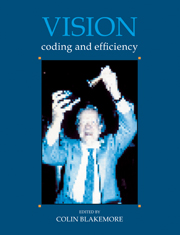Book contents
- Frontmatter
- Contents
- List of Contributors
- Preface
- Reply
- Acknowledgements
- Concepts of coding and efficiency
- Efficiency of the visual pathway
- Colour
- Brightness, adaptation and contrast
- Development of vision
- 19 On reformation of visual projection: cellular and molecular aspects
- 20 Retinal pathways and the developmental basis of binocular vision
- 21 Development of visual callosal connections
- 22 Sensitive periods in visual development: insights gained from studies of recovery of visual function in cats following early monocular deprivation or cortical lesions
- 23 The developmental course of cortical processing streams in the human infant
- 24 Maturation of mechanisms for efficient spatial vision
- 25 The puzzle of amblyopia
- Depth and texture
- Motion
- From image to object
- Index
21 - Development of visual callosal connections
Published online by Cambridge University Press: 05 May 2010
- Frontmatter
- Contents
- List of Contributors
- Preface
- Reply
- Acknowledgements
- Concepts of coding and efficiency
- Efficiency of the visual pathway
- Colour
- Brightness, adaptation and contrast
- Development of vision
- 19 On reformation of visual projection: cellular and molecular aspects
- 20 Retinal pathways and the developmental basis of binocular vision
- 21 Development of visual callosal connections
- 22 Sensitive periods in visual development: insights gained from studies of recovery of visual function in cats following early monocular deprivation or cortical lesions
- 23 The developmental course of cortical processing streams in the human infant
- 24 Maturation of mechanisms for efficient spatial vision
- 25 The puzzle of amblyopia
- Depth and texture
- Motion
- From image to object
- Index
Summary
A prominent characteristic of the connections between cortical sensory areas is the close relationship that the overall pattern of these connections bears to the orderly representations of the sensory periphery that are a ubiquitous feature of these cortical areas. This relationship holds true not only for projections that arise and terminate within the same cerebral hemisphere, but also for the extensive system of interhemispheric cortico-cortical connections. For example, the topography of the interhemispheric pathway between cortical visual areas is such that the highest density of these connections is commonly found wherever the vertical meridian of the visual field is represented.
Although a great deal is known about the arrangement of visual cortico-cortical connections in the adult, our knowledge of the process by which this intricate pattern of connections is specified during development is much less complete. No doubt this is due at least in part to the abundant numbers and highly interwoven nature of the afferent and efferent cortical pathways, which makes it difficult to manipulate and study the development of any one set of projections in isolation. However, the interhemispheric visual cortico-cortical connections have a unique trajectory that carries them through the corpus callosum, a broad fiber tract that is visible in the interhemispheric fissure from an early stage of development onward. For this reason, much of what we know about the development of visual cortico-cortical connections comes from studies of the visual callosal pathway.
- Type
- Chapter
- Information
- VisionCoding and Efficiency, pp. 224 - 233Publisher: Cambridge University PressPrint publication year: 1991



